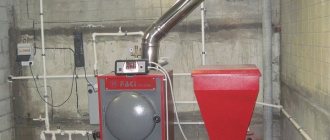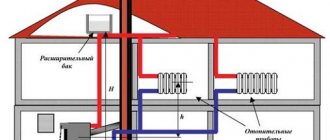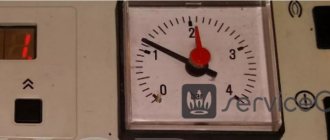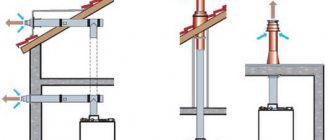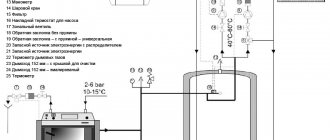Installation of a floor-standing gas boiler
It is advisable to entrust the installation of a floor-standing gas boiler to certified specialists from technical centers specializing in providing this type of service, since then they will draw up all the required documents, prepare the premises accordingly and give a guarantee for the types of work performed.
If we consider the design of the simplest gas boiler, then it is simple: a gas burner and a heat exchanger. It will not be difficult to connect water, gas, chimney and, if necessary, power supply to the device. The main requirement: obtain all necessary permits, otherwise penalties cannot be avoided.
A good choice for your own home is a double-circuit heating device with a boiler and an automation kit. A gas heating boiler of this type has an automatic system equipped with a microprocessor and a double thermostat, thanks to which the air temperature outside and in the house is monitored, and according to the parameters of the installed settings, when residents are absent, the temperature regime is reduced to a sanitary minimum.
In such a boiler, gas consumption is about 30-70% less than in devices with manual or semi-automatic adjustment. But such heating units still have a serious drawback - in the absence of power supply, the automation does not work and the boiler operates in minimal heating mode. To avoid interruptions in the heat supply to your home, you will need to organize an emergency power supply, which will lead to additional costs.
Advantages and disadvantages
Boilers with two circuits, like any other technological devices, have their advantages and disadvantages. Knowing them, it is easier to choose a unit for heating water and (convector) heating a house.
Double-circuit boilers have many advantages
The advantages of double-circuit floor-standing boilers are given below.
- The most important advantage of this unit is the ability to not only heat the house, but also provide it with hot water, which will be used for domestic needs.
- A wall-mounted gas boiler can separately perform the functions of a water heater and a heating device.
- It is possible to adjust the heating temperature of the liquid. On average, the boiler heats water to +30-40 degrees.
- The heating speed of the water is high - in order to wash, you can heat it (the water) in just a few minutes.
- Such units usually have a remote control system.
- Certain types of boilers can be modernized: it is possible to replace the burner, as well as convert the unit to a different type of fuel.
- The power of double-circuit floor-mounted installations is higher than that of wall-mounted ones.
- Floor-standing boilers are highly reliable compared to wall-mounted ones.
Heating water in a gas boiler
You should also know the disadvantages of double-circuit boilers.
- The secondary heat exchanger often becomes unusable, leaving the house without hot water.
- The double-circuit floor unit occupies a fairly large area. Its dimensions are approximately 80*50*80 cm, it weighs about 100 kg.
- Limited volumes of heated water - the boiler will not heat more water than it can. Therefore, if the consumption of hot water is high, then it is better to install a separate heater.
- Complex installation of equipment and the need to arrange a chimney that needs periodic cleaning.
- The floor-standing boiler makes noise during operation, so it is recommended to install it in the basement.
Floor-standing gas boiler Baxi Slim 2.300
In any case, purchasing one double-circuit floor-standing boiler is much cheaper than buying a separate single-circuit unit, and also a boiler for heating water. Also, the purchase of such a device is justified if the house is still under construction and the communications are not connected. Fortunately, the choice of models and types of floor-standing double-circuit boilers is quite large. You can read how to choose a solid fuel boiler for heating a private home in our article.
Features of installing a floor-standing gas boiler
A gas boiler, regardless of whether it is a floor-standing or wall-mounted model, should be installed in accordance with the rules and regulations:
- installation of a floor-standing gas boiler is carried out in a separate room, which is called a furnace or boiler room, with an area of at least 4 “squares”;
- ceiling height – from 2.5 meters;
- the volume of the room should be more than 8 m³ with a heating unit power of up to 30 kW, 13.5 m³ with 31 - 60 kW and 15 m³ with 61 - 200 kW;
- It is necessary to have an opening window;
- the width of the door in the boiler room cannot be less than 80 centimeters;
- finishing of the combustion chamber must be done using non-combustible materials;
- It is unacceptable to have a false floor or false ceiling in the room;
- It is mandatory to ensure the flow of air entering through a non-closing vent, the cross-section of which is 8 cm² per 1 kW of unit power.
If the boiler is equipped with a closed combustion chamber, then the volume of the combustion chamber is not subject to standardization. Regardless of the boiler model, the rules and requirements must be followed.
The exhaust of the heating unit, when a connection diagram for a floor-standing or wall-mounted gas boiler is being developed, is discharged into a separate flue (read: “Connection diagram for a gas heating boiler with examples”). It is prohibited to use ventilation ducts for such purposes, since combustion products can penetrate into other rooms of the house, and in apartments of multi-storey buildings - to neighbors.
Other requirements include:
- compliance with the length of the horizontal section of the gas duct within the boiler room is no more than 3 meters. The rotation angles cannot be more than 3. The flue must have a vertical outlet that rises above the ridge of the roof or above the gable of a flat roof by at least one meter. When installing a chimney for a gas boiler, you should use only solid materials that are resistant to chemical and thermal influences, since combustion products form aggressive substances when cooling. Layered materials such as asbestos cement pipes can be used, but if they are located at a distance of more than 5 meters from the exhaust pipe;
- Before installing a floor-standing gas boiler, it is necessary that the boiler room is properly prepared (for more details: “Rules for installing a gas heating boiler - installation and connection instructions”). The space in front of the unit is left free. A durable fireproof metal sheet measuring 1 by 1 meter is laid on the floor under the heating unit. Asbestos cement cannot be used, since neither firefighters nor gas workers recognize it - it wears out over time, and in addition, according to sanitary standards, it is prohibited to keep materials containing asbestos in residential premises;
- in the boiler room there cannot be places like cavities where combustion products or a gas mixture dangerous to human life can accumulate. In the case where a gas appliance is planned to be used to heat a house, gas workers will definitely check the condition of the heating structure in the apartment or house. In horizontal sections, pipes should be located at a slope that does not exceed 5 millimeters per linear meter in the direction of movement of the coolant. An expansion tank and an air valve should be installed at the highest point of the heating system. The heating structure must withstand the pressure testing process under a load of 1.8 bar.
It may seem that the rules for connecting a floor-standing gas boiler are strict, but gas is an explosive fuel and therefore everything must be connected in accordance with the requirements.
Installation of even the simplest model is not permitted in the following cases:
- if the apartment is located in an apartment building where there is no main gas duct;
- when the kitchen has a false ceiling that the residents do not want to remove, or a permanent mezzanine. If the bottom of the mezzanine is made of cardboard or wood, it is easy to dismantle it.
In the case where the apartment is not privatized, only a hot water boiler can be installed in it, since a gas appliance requires a separate boiler room, and this means redevelopment, which only homeowners have the right to do.
You can install any boiler in your own home, because the furnace room can be located outside the building. It is advisable that the boiler room is located outside the building, then supervisory authorities will have fewer reasons to make comments and conduct inspections. In a separate extension, it is possible to install a high-power floor-standing gas boiler, which allows heating not only living rooms, but also utility rooms.
For a small household, the optimal solution is to install a wall-mounted boiler, since it does not require a brick or concrete tray with 50-centimeter sides, as for a floor-standing heating unit.
Operating principle of the heating device
The design of a dual-circuit device consists of the following components: a heat exchanger and a pair of circuits. When the heating circuit is operating, no coolant enters the hot water circuit. To prevent coolant from entering the second circuit, a special valve is installed.
When you turn on the hot water tap, preference is given to hot water supply and the valve blocks access to the heating system circuit. When the tap is closed, the system resets to normal operation.
The operating principle of each device model depends on its design features. There are convection and condensation options for heating double-circuit gas boilers.
Convection units eliminate waste products and water vapor through the chimney. As for condensation types, they use additionally released heat and convert it into energy. The latter installation option is more rational and economical, but the cost of purchasing the unit itself is quite high.
Floor-standing equipment requires a lot of space to be placed and is not as compact as wall-mounted models, but it has more powerful characteristics, is reliable in use and will last a long time.
Preparing to install a floor-standing boiler
Before connecting a floor-standing gas boiler, you need to prepare tools and materials.
You will also need to study the unit installation instructions and operating manual. Materials and tools you need to have on hand:
- cement and sand;
- shovel;
- container for preparing the solution;
- drill;
- hammer;
- bolts and nails;
- wooden edging;
- pipes for the flue.
You can begin installing a gas appliance only after preparing the place for its location. The floor heating unit must be installed on a concrete base. The screed can be replaced with a flat metal sheet. It is placed under the legs of the boiler so that it protrudes onto the edges of the unit by at least 30 centimeters. The floor-standing unit must be absolutely level.
In apartments located in multi-storey buildings or in individual developments, boilers with a closed combustion chamber are installed, and a coaxial chimney is led to the street through the wall of the room. The hole for the flue, depending on the boiler model, is located either on its rear wall or on the top panel. As a rule, it is located at the back and thus the chimney can be easily brought out through the wall.
Where to begin
The choice of a gas device should be based not only on the capabilities of the homeowner.
It is necessary to determine the purpose of the unit; it is available in two formats - with one or two water circuits.
The single-circuit model serves only to heat the room, without obtaining additional benefits.
The dual-circuit device provides hot water and has a built-in coil. You can additionally install a heat accumulator where hot water will accumulate and immediately use hot water supply in large volumes.
You need to purchase equipment in stores where the products are fully certified, an official guarantee is issued, and a receipt is issued.
Gas boiler room standards
Equipment running on gas requires a separate room - a boiler room.
The room should have an area of 4 square meters. m, but the size of the boiler room depends on the power of the device: the more powerful the boiler, the larger the boiler room should be. The ceiling height must be at least 2.7 m.
Devices with a power of up to 15 kW can be installed regardless of the floor, but more productive ones are installed below the level of the first floor, preferably in the basement.
Standard requirements for a boiler room
Installation of the boiler or piping in the kitchen, living rooms, or bathrooms is not allowed.
A door is required with a gap of 2-3 cm at the top or bottom, which will ensure fresh ventilation of the boiler room.
The installation site must be strong and level. If a heavy unit is used, it is better to pour a foundation under it so that the area exceeds the dimensions of the bottom of the boiler by 10 cm in each direction.
Boiler room ventilation diagram
The walls and floors that will directly touch the unit are sheathed with sheet iron and covered with heat-resistant plaster.
A window of 30*30 cm is required, the larger the room, the more windows.
If the equipment has a closed combustion chamber operating on the convection principle, a dedicated room is not required.
The design of the device allows installation near any external wall; a coaxial chimney is used to remove combustion waste.
Coaxial chimney
The peculiarity of the coaxial pipe is the possibility of direct output through the wall, acting as a smoke exhaust and supply ventilation. The chimney simultaneously removes combustion products and captures street air, directing it to the burner.
The type of draft is considered more efficient than using air from the room.
The horizontal part of the pipe located in the house should not be more than 3 m, the number of turns of the chimney should not exceed 3.
Preparing the boiler room for acceptance by the gas service:
Preparing documents
It is necessary to study the standards and rules for installing a gas boiler.
You should familiarize yourself with SNiP 02/31/2001 on gas supply to a private house, 01/41/2003 on ventilation, heating, 01/21/97 on fire safety, 04/2/01-85 on water supply and sewerage. The latter is needed to properly supply water to the heat generator.
More details about the rules for arranging a boiler room are written in SNiP 2.04.08-87.
An application for connection must be sent to the local gas service, with preliminary calculations of the total gas consumption for heating.
To calculate the parameter, indicative SNiP 31-02 has been issued, where paragraph 9.1.3 displays the average daily fuel consumption rates for different devices.
If the answer is positive, the applicant receives a document describing the technical conditions for gas supply. You will be required to fully implement the requirements described in your permit.
Installation of gas equipment requires prior approval, even if the device will be powered by a cylinder.
After ensuring the conditions, they proceed to drawing up an installation project, which will be based on data from the official permit. The scheme is drawn up only by design specialists with a valid license.
An example of a gas boiler installation diagram
The completed project is sent to the local supply service for approval, copies of the technical data sheet of the device, instructions, certificates, examinations with a conclusion on the safety of the boiler are attached.
If the answer is negative, the motivating part will be described with a list of points that require correction. After eliminating the shortcomings, you can resubmit the documents.
Installation of a floor-standing gas boiler
When the base is prepared, the device is placed on it so that the distance between the wall and the back of the boiler allows servicing and inspection of the equipment. Then they mark the location of the chimney. According to the rules and requirements, the chimney pipe is placed to the side at a distance of 60 centimeters or more from the window opening. Such requirements are explained by the need to prevent exhaust gases from entering the premises.
Often, in many apartments located in old multi-story buildings, as well as in small kitchens, gas equipment is installed directly under the window. If the supervisory services have allowed this installation option, the chimney should be installed away from the vent or opening window.
At the place where the location of the heating unit is marked, make a hole with such a diameter that the chimney pipe can freely pass through it (about

